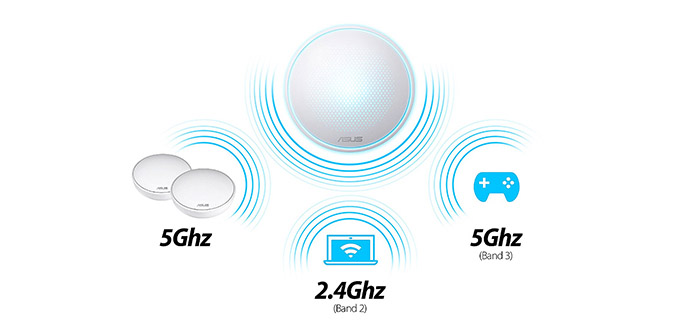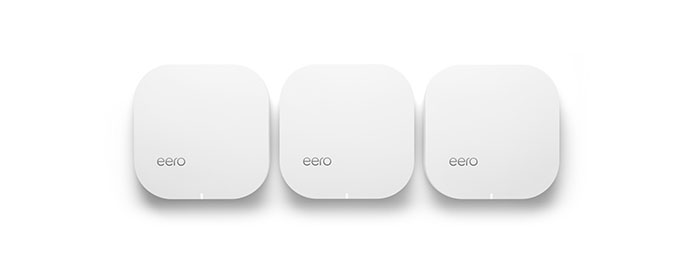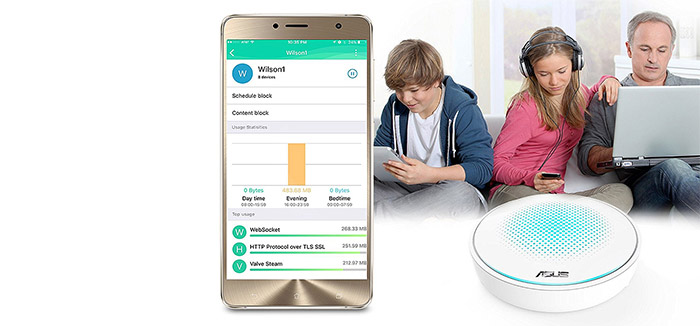By default, Asus Lyra will let one of the two 5GHz radio bands to dynamically become the dedicated backhaul band, but, as for the client connection, they can either connect to the ‘dedicated’ radio band or, similarly to the Orbi, the clients can be forced to connect only to the two other available radio bands (the user can also allow a client that has made multiple attempts to connect to the backhaul radio over the course of 30 seconds to connect to that 5GHz radio band).
Both the Asus Lyra and the Eero Second Generation support the Ethernet backhaul feature so, in case some cables are already installed inside your home or you won’t be bothered by adding some additional wires, then you could have a better performing WiFi mesh system.
Eero went some steps further and it also implemented the support for 802.11r Fast BSS transition, a feature which ensures that the user can roam seamlessly from one node to the other since the Eero routers are already aware of each other’s existence (the handshake has been done prior to the roaming), so the user won’t experience any disconnects and reconnects.
One technology that can be found on both WiFi systems (and with almost all other systems available on the market) is the Mu-MIMO (Multi-User Multiple-Input and Multiple-Output) tech, which allows multiple clients to be served simultaneously instead of letting them compete for the bandwidth and be served one at a time (is also used for inter-node connectivity), but the problem is that even more than a couple of years after it went into the mainstream, this technology is still very rarely being implemented with newly released devices and even then, at a very basic level.
So, while the manufacturers have been pushing the MU-MIMO to surely be part of the future of the networking devices, I’m not entirely sure it will be in this format (possibly an evolved or modified version will be more successful). One interesting feature that the Eero WiFi system has, but the Asus Lyra does not is the BeamForming feature (I was unable to find the Airadar feature anywhere on the Lyra’s user interface) which has the role of focusing the signal towards the compatible wirelessly-connected clients instead of broadcasting it everywhere in the hopes that it will reach the devices.
In order to test the wireless performance of these two WiFi systems, first, I connected one unit to a modem, then I created a network to which I added a compatible wireless client (3×3 laptop) and afterwards, I tested the speed performance at various points inside the home with a one unit set up, two nodes and three nodes. So, I took a Eero router and created a network to which I added the client and, using the 5GHz radio band (the 802.11ac standard), I managed to measure an average of 441 Mbps, 5 feet away from the router and 223 Mbps at 30 feet.
Next, I added the second Eero node to the network (about 35 feet away from the main router) and, keeping the same client, I managed to measure an average of 335 Mbps at 5 feet and around 248 Mbps at 30 feet. Lastly, I added the third Eero node (from the Pro package) and I positioned the device at about 40 feet from the main unit, but with a couple of thick walls between them. At 5 feet, I measured an average of 302 Mbps, while at 30 feet, the speed went down to 210 Mbps.
On the next step, I took one Asus Lyra unit, created a new network and added the same wireless client: 5 feet away, I managed to measure an average of 504 Mbps, while at 30 feet, the speed went down to 137 Mbps. Afterwards, I added the second Lyra node to the network and using the wireless client, I managed to measure an average of 196 Mbps, but at 30 feet, the speed went down to 122 Mbps. Lastly, I added the third Lyra node and keeping the same setup as with the Eero (40 feet away from the main unit and with a couple of thick wall in-between), I measured an average of 152 Mbps at close range (no more than 5 feet) and 119 Mbps at 30 feet.
As can be seen from the results, Eero hasn’t necessarily focused towards delivering the fastest wireless speed, but it does have one of (if not the most) consistent speed performance I’ve seen on a WiFi system (couple that with its stability and we’re dealing with one of the best tri-band WiFi systems available right now). The Asus Lyra on the other hand has severe issues on the handling of the backhaul traffic, so, while you may get away with using a single router, the multi-unit Lyra still needs some updates to make it competitive from the wireless speed performance point of view.
Since there still are some devices which support only the older standard (the 802.11n with support only for the 2.4GHz band), I took one such client and I connected it to each of the two systems. First, I added the 2.4GHz wireless client to the Eero system and, close-by (no more than 5 feet), I measured an average of 158 Mbps. while at 30 feet, the speed went down to 95 Mbps. Next, I added the wireless client to the Asus Lyra system and, at 5 feet, I measured an average of 167 Mbps, while at 30 feet, the speed decreased to 98 Mbps.
Verdict: Both the Asus Lyra and the Eero Second Generation are equipped with every feature one would expect from a powerful tri-band WiFi system (the mesh technology, MU-MIMO) and more (Fast BSS transition) but, while the Lyra has a slight advantage using the older WiFi standard, it is overshadowed by the stellar wireless performance of the Eero 2nd Generation using the 5GHz radio on the 802.11ac standard. Of course, Asus seems to have made great progress with its AiMesh software and I doubt the problem lies within the internal hardware of the Asus Lyra, so we may see an update to fix this performance issue, but until then, Eero is the winner.
ALSO CHECK OUT: LINKSYS VELOP VS NETGEAR ORBI
Setup and Interface
Eero first gen was among the first to completely remove the web-based interface and completely rely on a mobile app for the initial configuration process, as well as for the maintenance and the monitoring of the network. The Second Generation Eero has kept the same approach, so the only way to interact with the interface is through a dedicated mobile app. The set up process is simple and intuitive and all the user has to do is to create a new account (which requires the mobile phone number), power on the unit so it gets discovered by the app and once it does, select a name for it, the location, the SSID and passkey.
The Asus Lyra can be configured and managed through a mobile app, but, unlike Eero, it has also decided to keep the web-based interface, so the user can either choose between the two or use both (a laudable decision since it gives the user much more liberty and an easier access to all the system’s functions and features).
The initial set up process (using the app) is quite similar to what the other WiFi systems have to offer, so you have to power on the Lyra unit and wait until it pairs with the app and, afterwards, create an admin profile, insert the SSID and the passkey. But, the initial configuration process is not as fast as it should be and it will take more minutes to finish it than using the Eero.
The web-based interface seems to be the advantage that Lyra has over Eero and, surprisingly, the manufacturer has ‘constrained’ the users to use it alongside the app since some features can only be found on the mobile application, while others only on the web-based interface.
So, both the app and the interface share the Guest Access feature (here, you can create a separate guest network), the Family Members feature (to create separate profiles for each family member with its own set of assigned devices and with a specific type of content that they can visit), Traffic Manager (create priorities based on categories for different applications), Port Forwarding, IP Binding, Remote Control, and more.
The web based interface does offer access to the AiProtection, a protection tool against malware, spam and similar type of intrusions and Traffic Manager offers a different set of options, allowing the use of the well-known Adaptive QoS, where the user can set priorities for each connected device.
The Eero has its own set of interesting features, such as the Guest Access (you can create a guest network), DHCP & NAT Reservations, Port Forwarding, UPnP and Family Profiles, which allows the user to create different schedules for the Internet access for each family member. If you need actual Parental Controls and Content Filtering, you need to purchase the Eero Plus package, which also adds protection against many types of intrusions, such as malware, phishing, viruses or ransomware.
Verdict: The Asus Lyra has the disadvantage of having a slower initial set up process, but, it does have a web-based interface (which, unlike the mobile apps of most WiFi systems, feels less like a maze) and it has more advanced features that the user can use from the beginning (and which are free of charge), while Eero requires a fee for some of them. This makes Asus the winner of this round.
ALSO CHECK OUT: GOOGLE WIFI VS EERO 2ND GENERATION
Conclusion
Eero is among the first manufacturers to release a home-suitable WiFi mesh system and the launch of the second generation Eero (both the Pro and the Home packages) was a step forward and a necessity in order to still remain competitive against its main tri-band rivals (such as Orbi or Velop). Asus has waited a really long time to release the Lyra system and, similarly to Eero 2, it also aimed at the more powerful tri-band WiFi systems which are more suitable for medium-to-large homes.
There are lots of common elements between these two systems, such as the minimalist design approach, the small-form factor cases, the number of Ethernet ports and the proprietary mobile apps, but there are some fundamental differences that will most likely be decisive factors for anyone unsure which of these systems to purchase.
First, there’s the web-based interface and the larger number of free features that are available on the Asus Lyra which could have the potential to balance everything in Asus’ favour, but the Lyra has serious problems with handling the multiple unit configuration and, as can be seen in the testing part of the article, the wireless performance was well below what the other tri-band WiFi systems can offer and especially underneath the far reaching and incredibly stable Eero 2nd Generation.
So, as a conclusion, the Asus Lyra has the potential to get better after some future updates (the AiMesh development is proof of concept), but, right now, Eero 2nd Generation is the better WiFi system and is what Asus Lyra should have been from the beginning.
Check the products here:
Asus Lyra:

Mark is a graduate in Computer Science, having gathered valuable experience over the years working in IT as a programmer. Mark is also the main tech writer for MBReviews.com, covering not only his passion, the networking devices, but also other cool electronic gadgets that you may find useful for your every day life.











